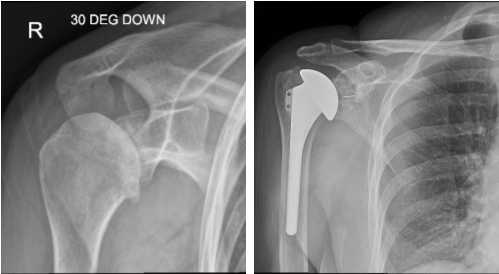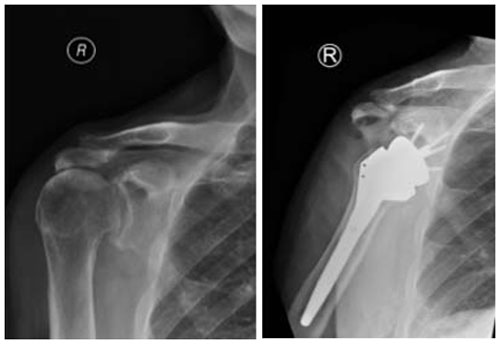However standard shoulder replacements can’t be used when there are no rotator cuff tendons. If a conventional replacement is used, the ball would slowly move up (superiorly) due to no rotator cuff tissue to hold it centred in the socket. As a consequence, the glenoid (socket) replacement would loosen and the conventional replacement would fail.
The answer to this dilemma was to reverse the socket and the ball, placing the ball portion of the shoulder where the socket used to be and the socket where the ball or humeral head used to be (ie the reverse total shoulder replacement).
With this new configuration, existing muscles such as the deltoid can adequately support the joint in the absence of a functioning rotator cuff. The deltoid muscle that covers the shoulder is used to lift the arm, providing better function of the shoulder. The result is a better functioning shoulder with less pain.
The reverse shoulder replacement was originally designed in France in the late 1980’s and has slowly become available in Australia since the early 2000’s. With newer designs and a better understanding of the mechanics of the prosthesis, the outcome from such surgery has become much more predictable and with less complications for the patients.
How do patients present?
This condition usually occurs in older individuals and results in a painful shoulder with loss of motion and strength. Often, individuals cannot raise the arm to shoulder level making it difficult to perform routine activities of daily living.
How is the diagnosis made?
Plain x-rays will show evidence of arthritis and also what is described as “superior migration of the humeral head” in which the humeral head or ball of the shoulder can be seen sitting high in the glenoid because the rotator cuff is no longer able to hold it centred in the glenoid or socket.
An MRI is also used in the diagnosis to assess the rotator cuff, specifically looking for chronic tearing, retraction and atrophy of the cuff. These findings confirm that a reverse replacement is the best option as surgical repair of such poor tissue would fail.
How are these problems treated?
Non-operative Management
Conservative management is always an option and this would be in the form of avoidance of the activities which cause the symptoms and also pain relief. Physiotherapy would not be a feasible option with this condition as the rotator cuff is torn and retracted therefore unable to be strengthened with exercise.
Operative Management
The operative solution is a reverse shoulder replacement. The two-hour surgical time is similar to the conventional procedure and the outcome in terms of range of motion, pain relief and function is also becoming similar.


